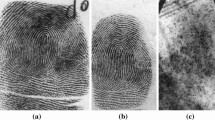Abstract
Over the past few years, fingerprints have been considered the most sensitive and crucial identification basis for low enforcement agencies. In crime scene and forensics, recording of latent fingerprints from uneven and noisy surface is a difficult task and conventional algorithm fails in most of the times. A robust orientation field estimation algorithm is the need of the time to recognize the poor quality latent. To overcome the limitations of conventional algorithm, various techniques have been proposed in the last decade. In this paper, a comparative study has been done of state-of-the-art techniques with their advancements and limitations. Our proposal aims at effectively minimizing the difficulties faced to separate ridges and segmentation of latent images reducing search time and computational complexity while optimizing the system retrieval performance.
Access this chapter
Tax calculation will be finalised at checkout
Purchases are for personal use only
Similar content being viewed by others
References
Arora, S., Cao, K., & Jain, A. K. (2014). Latent fingerprint matching: Performance gain via feedback from exemplar prints.
Cao, K., & Jain, A. K. Fingerprint indexing and matching an integrated approach. Michigan.
Sherlock, B. G., & Monro, D. M. (1992). A model for interpreting fingerprint. USA.
Brazen, A. M. & Gerez, S. H. (2002). Systematic methods for the computation of the direction fields and singular points of fingerprints. IEEE.
Zhu, E., & Yen, J. (2006). Systematic method for fingerprint ridge orientation estimation and image processing. China: Elsevier.
Liu, M., & Jiang, X. (2004). Fingerprint reference point detection. Singapore: EEE Nanyang Technological University.
Zhou, J. (2003). A model-based method for the computation of fingerprints’ orientation field. China: IEEE.
Hong, L. (1998). Fingerprint image enhancement: Algorithm and performance evaluation. Michigan.
Jain, A. K., & Feng, J. (2011) Latent fingerprint matching. IEEE.
Karimi-Ashtiani, S., & Jay Kuo, C.-C. (2008). A robust technique for latent fingerprint image segmentation and enhancement. In 2008 15th IEEE International Conference on Image Processing. IEEE.
Ruangsakul, P., et al. (2015). Latent fingerprints segmentation based on rearranged fourier subbands. In 2015 International Conference on Biometrics (ICB). IEEE.
Zhang, J., Lai, R., & Jay Kuo, C.-C. (2013). Adaptive directional total-variation model for latent fingerprint segmentation. IEEE Transactions on Information Forensics and Security, 8(8), 1261–1273.
Li, B., et al. (2011). Surface wrinkling patterns on a core-shell soft sphere. Physical Review Letters, 106(23), 234301.
Goswami, G., et al. (2013). On RGB-D face recognition using Kinect. In 2013 IEEE Sixth International Conference on Biometrics: Theory, Applications and Systems (BTAS). IEEE.
Fu, F. (2005). Structural behavior and design methods of tensegrity domes. Journal of Constructional Steel Research, 61(1), 23–35.
Liang, X., Bishnu, A., & Asano, T. (2007). A robust fingerprint indexing scheme using minutia neighborhood structure and low-order Delaunay triangles. IEEE Transactions on Information Forensics and Security, 2(4), 721–733.
Moses, K. (2009). Automatic fingerprint identification systems (afis). In Fingerprint sourcebook, international association for Identification. Washington, DC: National Institute of Justice. http://www.ncjrs.gov/pdffiles1/nij/225326.pdf.
Paulino, A. A., Feng, J., & Jain, A. K. (2013). Latent fingerprint matching using descriptor-based hough transform. IEEE Transactions on Information Forensics and Security, 8(1), 31–45.
Jain, A. K., & Feng, J. (2011). Latent fingerprint matching. IEEE Transactions on Pattern Analysis and Machine Intelligence, 33(1), 88–100.
Yoon, S., Feng, J., & Jain, A. K. (2010). On latent fingerprint enhancement. In Biometric technology for human identification VII (Vol. 7667). International Society for Optics and Photonics.
Zhao, Q., Feng, J., & Jain, A. K. (2010). Latent fingerprint matching: Utility of level 3 features. MSU Technical Report, 8, 1–30.
Sankaran, A., et al. (2011). On matching latent to latent fingerprints. In 2011 International Joint Conference on Biometrics (IJCB). IEEE.
Sankaran, A., Jain, A., Vashisth, T., Vatsa, M., & Singh, R. (2017). A research paper on Adaptive latent fingerprint segmentation using feature selection and random decision forest classification. Elsevier.
Said, A., & Peralman, W. A. (1996). An image multiresolution representation for lossless and lossy image compression. IEEE Transaction on Image Processing, 5, 1303–1310.
Xiong, Z., Ramchandran, K., & Orchard, M. T. (1998). Wavelet packet image coding using space-frequency quantization. IEEE Transaction on Image Processing, 7, 892–898.
Author information
Authors and Affiliations
Corresponding author
Editor information
Editors and Affiliations
Rights and permissions
Copyright information
© 2020 Springer Nature Singapore Pte Ltd.
About this paper
Cite this paper
Singh, H.P., Dimri, P. (2020). A Survey of Latent Fingerprint Indexing and Segmentation Based Matching. In: Kolhe, M., Tiwari, S., Trivedi, M., Mishra, K. (eds) Advances in Data and Information Sciences. Lecture Notes in Networks and Systems, vol 94. Springer, Singapore. https://doi.org/10.1007/978-981-15-0694-9_62
Download citation
DOI: https://doi.org/10.1007/978-981-15-0694-9_62
Published:
Publisher Name: Springer, Singapore
Print ISBN: 978-981-15-0693-2
Online ISBN: 978-981-15-0694-9
eBook Packages: EngineeringEngineering (R0)




